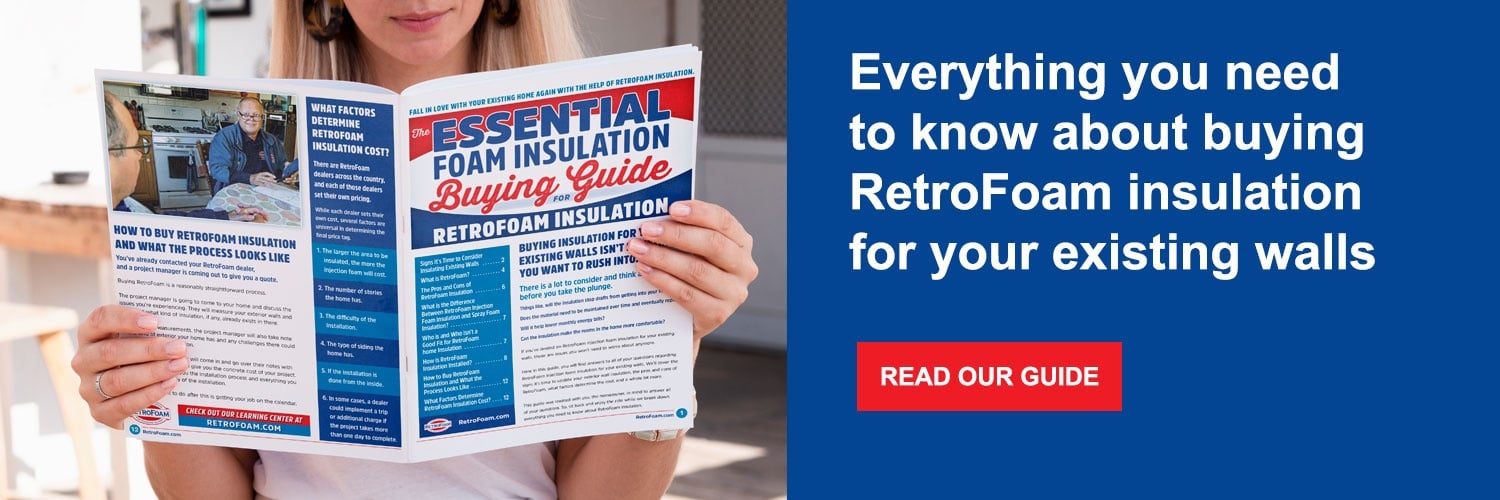Does RetroFoam Insulation Make a House too Airtight?


You’ve read about how RetroFoam insulation can create an air seal in your home, but will it make your house too airtight?
That is a common misconception about foam insulation -- is that it makes the home so tight it can’t breathe. The thing is, it’s not so much that your house needs to breathe, but it’s more about air quality and humidity levels.
RetroFoam dealers across the country have been making homes more energy-efficient and comfortable by installing injection foam insulation. That injection foam creates an air seal in the exterior walls that just isn’t possible with traditional insulation.
We love educating homeowners about RetroFoam insulation and what it has to offer. We also love clearing up misconceptions that run rampant about foam insulation.
Can a House Be too Airtight After RetroFoam is Installed?
Your concern is that RetroFoam is going to make your home too tight, which can impact the air quality and humidity in your house.
If you’re only adding injection foam insulation to your exterior walls, then it’s not really possible to make your home too tight. This is because air can still move from the crawl space and attic with little to no insulation and no air seal.
These air leaks can lead to other comfort and energy-efficiency issues in your home, which is why many homeowners opt to seal their entire building envelope.
If you plan to seal your entire building envelope by adding spray foam to your attic, crawl space, and rim joist, then there is the possibility your house could be too tight.
Now let’s talk about a little science -- Air Changes Per Hour and what the humidity level should be in your home.
Air Changes Per Hour
A house being too tight really centers around Air Changes Per Hour, or ACH.
Air Changes Per Hour is the number of times, per hour, that enough air enters or exits your home to fill the volume of it. Not all of the air in your home is replaced at once, as some will linger as some is replaced. It can take several cycles for all the air to be replaced entirely in your home.
The amount of ACH your home has depends on the building code and climate zone where you live. The number is between three to five, depending on your climate zone.
The ACH in your home is an important thing to know because you’ll see if you’re losing too much air that you’re paying to heat or cool. It also lets you know if you’re not replacing air in your home fast enough.
So, how do you figure out the ACH?
First, you’ll have to have a blower door test done in your home. This is a test performed by a professional energy auditor to test the airtightness of your home using a special fan. The blower door is set up in an exterior doorway. The fan pulls air out of the house, lowering the air pressure inside.
This test measures the air exchanges in your home and will give you the cubic feet per minute (CFM). Then it’s time to do some math.
The air changes per hour formula is CFM multiplied by 60, which gives you the cubic feet per hour. Next, you will need the volume of your house (length x width x height).
When you have the cubic feet per hour and the volume of the house, it’s time to divide them. When you divide the cubic feet per hour by the volume of the home. All of this math will tell you how many times per hour your home is filled and emptied with air.
What Should the Humidity in Your House Be?
When you think of humidity, you’re likely thinking in terms of the weather.
But did you know that the inside of your home has an ideal humidity as well?
The relative indoor humidity should be between 30 to 50 percent, according to Bob Vila. If the humidity is higher than 50 percent, your home will be uncomfortable and have increased air moisture. That moisture can lead to condensation and the growth of mold and mildew.
You can monitor the humidity in your home with a hygrometer, which you can pick up at any home improvement store.
If you find your indoor humidity is high, you can turn down or turn off your humidifier. You can also buy a dehumidifier to help bring the humidity down.
If you find you need to raise your humidity, turning your humidifier up can help.
Fixing an Airtight House
When your home was built, the HVAC system was installed by specification to the size of your home.
When you create an air seal in your home, there is the possibility your HVAC system will contribute to your home being too tight with the addition of foam insulation.
This isn’t a common occurrence, but there is a quick solution to fix it if it were to happen.
Turning on your bathroom fan or kitchen hood once a day will exchange the air in your home, so you have fresh air coming in.
Create an Air Seal in Your Home
Creating an air seal in your home doesn’t always make it too tight.
In some cases, the air seal created by RetroFoam insulation in your walls can combat humidity issues. RetroFoam acts as a barrier between the moisture in the air outside and your interior living space.
If you would like to learn more about what RetroFoam has to offer, check out the Learning Center on our website.
Related Articles
What is the Best Type of Insulation for Insulating Existing Walls?
What Causes Condensation on Walls in a Home?
About Amanda Emery
Amanda previously has worked as a breaking news and crime reporter, TV news producer, and editor. As a journalist, she has won several awards from The Society of Professional Journalists - Detroit Chapter and the Michigan Press Association. Amanda uses her experience as a journalist to write content that will help educate homeowners on foam insulation benefits. When Amanda isn’t writing, she’s spending time with her husband Chris, daughter Lilith-Maeve, and rescued huskies Danger and Wendigo. She also loves knitting, making art, and cooking.


